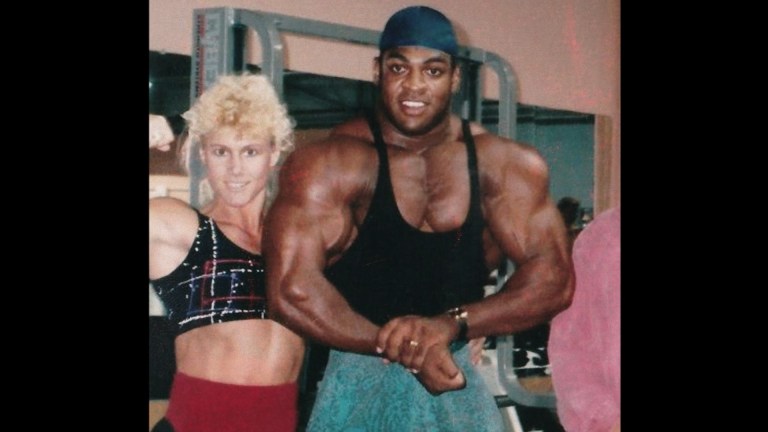Killer Sally: The True Story Behind the Netflix Doc
Netflix's latest true crime doc Killer Sally gets a lot right but here is the full story of Sally McNeil.

This article contains spoilers for Killer Sally.
Netflix’s Killer Sally is a rare breed of true crime story where not only is the murderer involved, she wants you to listen to her story.
Sally McNeil may look bold and brash, with literal award-winning muscles and an army of fans who paid her to throw them around, but in reality McNeil was stuck in a devastating cycle of abuse, not least of which from her husband, Ray McNeil.
This all came to a head on Valentine’s Day, Feb. 14, 1995, when she called the police to inform them she had shot her husband after he had tried to attack her.
What followed became a long and difficult trial which focused on two things – was it an act of self-defense, or was she a bitter wife with anger issues, lashing out at a husband who was going to leave her for another woman?
Killer Sally delves into both sides of this argument. In the eyes of the law, she’s a guilty woman, with prosecutor Daniel Goldstein successfully portraying her as someone who ‘simply couldn’t have been abused’, and saying in court: “she is a bully, and she is a thug. Sally McNeil has managed to bridge the gap of gender and become someone who is physical and confrontational.” He later stands by this statement in the documentary, claiming a “violent person cannot be a battered woman.”
But the truth is far more complicated than that.
Sally and Ray McNeil’s Marriage
For starters, McNeil had been physically abused from a young age – first by her family, and later by her first husband, Anthony Lowden, with whom she had two children, Shantina and John. She was in the Marine Corps at the time of her first marriage.
When she met Ray in June 1987, the pair became inseparable, bound by a love of the bodybuilding community and their desire to be the best. They were married within two months.
But their competitive drive proved to be a sticking point in their relationship, with Ray in particular becoming obsessed with championships and bodybuilding performances. This later gave way to steroid abuse on both sides, which as a side effect causes violent rages. Times of familial bliss for McNeil and her children, who took to calling Ray “dad,” were interspersed with moments of physical abuse, mainly aimed at Sally.
Speaking on the documentary, Shantina recalls a time Ray was moonlighting as security at a bar, and returned home covered in blood after pulling out the eyes of an unruly customer in a tussle. This is later corroborated by one of Ray’s friends who was working with him.
Abuse within the house was therefore sadly, somewhat of an inevitability, with McNeil and Ray both becoming violent at times – but it was McNeil who really drew the brunt of the physical altercations. She later started working in videotapes that showed off her physique to make extra cash, and people would hire her to lift them and perform wrestling moves on them.
While McNeil insists she never slept with clients, there is an acknowledgement from all involved that the tapes, and her work, fell into some line of fetishization. It was on these tapes she earned the nickname of Killer Sally, and effectively made her the breadwinner of the family.
As Ray’s star on the bodybuilding circuit began to fade, he became even more determined to do better, taking more steroids in order to improve his positioning. A particular failing came in 1993, when he successfully entered the Mr. Olympia competition – something Sally refers to as the Holy Grail of bodybuilding competitions – to eventually place 15th.
He also began to cheat on McNeil, with one woman being beaten up by Sally after their affair was discovered.
What Happened on the Night of Ray McNeil’s Murder?
On Feb. 14, 1995, Sally claims she was being choked by her husband when she snapped, picked up the sawed-off shotgun she had in the family home, and shot him twice when he refused to leave the house and came at her.
Those who knew Ray claim he was planning on leaving her for another woman.
Despite being shot in the chest and face, Ray managed to cling on to life before eventually dying in hospital a few hours later. The autopsy showed at the time of his death, he had five different types of steroids in his system.
In the interrogation room, Sally freely admits that she shot him, but maintains it was self-defense. Her children on tape are seen corroborating this, with John telling her at the police station she would be OK because she was trying not to get hurt.
When she was charged, her children were taken into a care home, before eventually moving in with their maternal grandparents, where they would remain for the rest of their childhood.
Prosecutors tore apart Sally’s typically-considered masculine lifestyle, and claimed because she was a Marine and a bodybuilder, she had naturally violent tendencies who had intended to kill Ray from the outset. They claimed she had intended to kill Ray from the outset, and that she couldn’t be a “beaten woman” because…essentially, “well, look at her.”
This was made worse when her Killer Sally videos were made admissible in court, with some videos showing her in army gear, holding the shotgun she used to shoot Ray with, painting a picture of someone who was not a persona for the camera, but rather her actual personality.
She was convicted of second-degree murder – meaning while there was no pre-meditation, she was intending to kill or cause serious harm. In 1996, she was sentenced to 19 years to life for the killing.
Where Are Killer Sally and Her Children Now?
In a rarity for true crime shows, Sally McNeil’s story has a somewhat happy ending – though it took decades for everyone involved to get there.
From 2011, Sally began petitioning for parole, and was turned down four times because they refused to believe she was a battered woman, and therefore she “wasn’t taking accountability for her actions”.
Speaking in the documentary, Sally said: “The last time I went to the parole board, I had to say it was my intention to kill my husband, like as though he never abused me, or beat me, or broke my bones or choked me. It was all me and I accepted responsibility.”
After 25 years, she was released from the Central California Women’s facility in the summer of 2020, and began to rebuild her life, residing at the Veterans Transition Center. She got a job at a warehouse and fell in love again.
Shantina and John, as they grew up, stopped their annual visits to see their mother, as they were embarrassed to explain why she was in prison. Shantina believes her last visit was around 2004.
In a chilling replication of her mother’s experience, Shantina also joined the military, and found herself in a three-year abusive relationship. She now has a son, and was reunited with Sally in the documentary.
John would also later join the military, serving in Afghanistan, and while they would initially keep in touch, he cut ties with her after having a daughter of his own, having grown resentful of what she allowed them to witness as children. He later entered a treatment program for PTSD, and drugs and alcohol addiction.
In 2022, Sally and Stewart Norfleet got married. Both Sally’s children, and her grandchildren were present at the wedding, with John giving her away. They are now hoping for a more positive future together.
Killer Sally is available to stream now on Netflix.
